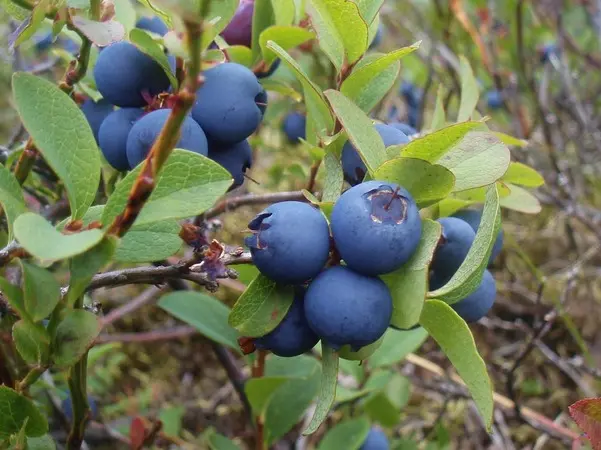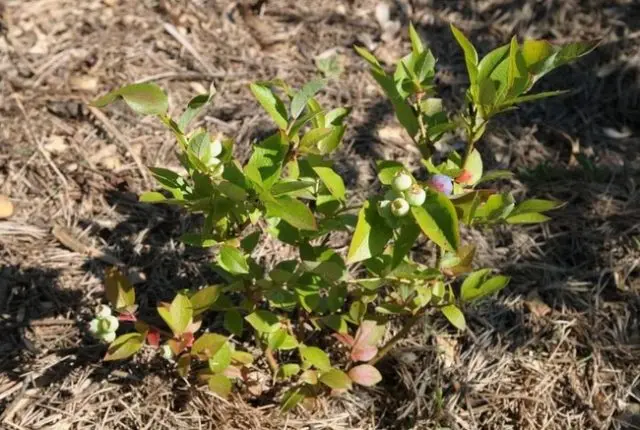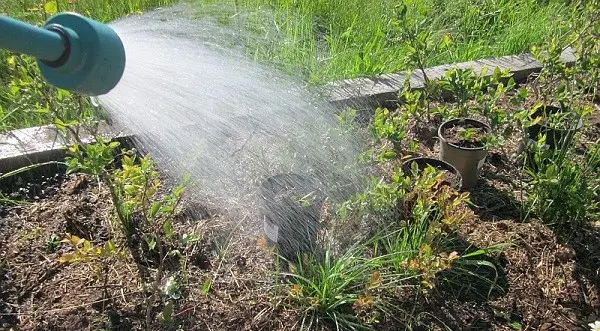Contents
Planting and caring for blueberries in the Urals has its own characteristics. The success of cultivation will depend on the correct choice of variety and planting. It is important to perform agrotechnical procedures – watering, fertilizing, weeding, pruning. Caring gardeners will appreciate the berry with a good harvest.
How blueberries grow in the Urals

There are currently over 700 varieties of blueberries. Most of them tolerate low temperatures -36…-38°C. There are heat-loving varieties that cannot withstand frosts below -24°C. They were obtained in America, Florida. Such varieties are grown in the Urals, covering each bush with spruce branches and falling asleep with snow when it falls. Some gardeners plant heat-loving blueberries in tubs, and, with the onset of frost, hide them in herds.
The best varieties of blueberries for the Urals
Despite the wide variety of modern blueberry varieties, frost-resistant varieties are suitable for growing in the Urals.
What varieties of blueberries are best grown in the Urals
When choosing a blueberry variety for the Urals, it is necessary to take into account not only the quality of the fruit, yield and disease resistance, but also the frost resistance zone. The State Register includes six varieties of the High Blueberry species recommended for cultivation in all regions of Our Country:
- Bluecrop – a variety of medium ripening, medium height.
Dark blue berries of dessert taste, weighing up to 1,9 g. Easily tolerates frosts down to -25°C. In cold winters, it needs insulation.
- Huron – berries for universal use are not very sweet, weighing up to 2,6 g.
The shoots are light green, hairless, the bush is tall. Tolerates frost down to -25°C.
- “Duke” – medium-sized semi-spreading bush with straight, hairless shoots of greenish-red color.
The ripening period of the crop is early. The berries are flattened, blue, weighing up to 2,9 g. The taste of blueberries is sweet, the aroma is pleasant. Damaged at temperatures below -30°C.
Sorts “Liberty”, “Aurora”, “Draper” in the Urals, they can only be grown in greenhouses or containers, as they cannot tolerate frosts below -20°C.
For the Urals, varieties of the species Blueberry marsh are suitable, they endure frosts down to -42 ° C, and are resistant to diseases. The following are included in the State Register:
- “Blue placer”;
- “Graceful”;
- “Iksinskaya”;
- “Nectar”;
- “Wonderful”;
- “Taiga beauty”;
- “Shegarskaya”
- Yurkovskaya.
The berries of the listed varieties are about two times smaller than those of the High Blueberry, they are not so sweet, but healthy and fragrant.
Planting blueberries in the Urals
For planting and growing blueberries in the Urals, seedlings with closed roots are purchased. 2-3 different varieties are planted on the site for cross-pollination.
Recommended dates

Seedlings with a closed root system can be planted in the Urals during the growing season. Best of all, they transfer transplantation to a permanent place in August, when there is no strong heat, and in spring, in May.
Site selection and soil preparation
Blueberries love sunny, well-lit places, protected from cold winds. The acidity of the soil for cultivation should be pH 4,5-5. In sandy soil, the plant feels better than in clay, heavy soil. When planting, sour peat, rotted sawdust and coniferous litter are added directly to the hole.
Blueberry roots live in symbiosis with mycorrhiza, a special fungus that helps the plant absorb water and nutrients. Only an acidic soil environment is suitable for mycorrhiza. Therefore, a bush planted in ordinary garden soil with neutral acidity stops growing and soon dies.
How to plant blueberries in the Urals
Nearby gardens grow crops with different soil and care requirements. Blueberries are different from most garden crops. Description of planting blueberry seedlings in the Urals in spring:
- The seedling is soaked in water for 3-4 hours, freed from the container.
- Prepare a hole with a diameter of 40 cm and 50 cm in depth.
- Black sour peat is poured at the bottom, and mixed with rotted sawdust. Fill the hole 1/3 full.
- The soil of the site is fenced off from the contents of the hole in which blueberries will grow. This can be done using boards, logs, polypropylene bags without a bottom, or thick plastic, which is sold in garden centers.
- The fence is installed along the outer diameter of the pit to form a partition that separates two layers of soil – outer and inner.
- The root of the seedling is slightly kneaded, without destroying the earthen ball, entangled in small roots.
- The hole is watered, a seedling is placed in the center.
- The empty space is filled to the top with sour red peat, and lightly tamped, then watered.
- The trunk circle is mulched with coniferous litter with a layer of 4 cm, then covered with straw to protect it from drying out. Again, the seedling is watered from above over the straw and leaves.
When planting, you can not make manure and ash.
Growing blueberries in the Urals
There are several ways to plant blueberries in the Urals. They are divided into industrial and private, for small garden plots. In a large field, there is no need to fence each bush separately, because they all grow as a monoculture and help each other.
The plant is propagated by layering. To do this, the side branch is bent to the ground and dug in with soil, leaving the top on the surface. After one and a half to two years, a new bush will grow from the cuttings, which can be separated with a pruner and planted in a new place.
Watering and fertilizing schedule

After planting blueberries in the Urals, according to gardeners, care comes down to regular watering. It is especially important in the phase of laying flower buds. The formation of buds for future fruiting occurs in July-August. If the plant lacks nutrition and water during this period, there will be no harvest.
For the normal growth of blueberries in the Urals, it is necessary to acidify the soil in which it grows in spring and autumn. For this, colloidal sulfur is used. It is scattered in the amount of 2 tbsp. l. under each bush, and cover with a layer of mulch.
In order for blueberries to please the harvest and grow well, in addition to maintaining the required level of soil acidity, top dressing is important. There are specialized mineral fertilizers with a high sulfur content, such as Florovit. Feed the plant in early May.
Loosening and mulching the soil
The best mulch that further increases the acidity of the soil is pine litter. But you can use coconut fiber and hay for this.
Under a layer of mulch, mycorrhiza reproduces more intensively. The nutrition of blueberries is improving, and it is changing before our eyes – the shoots become powerful, the leaves are shiny and juicy with a bright green color. The yield and size of berries increase. Such a plant will be able to successfully withstand frost, drought, high humidity and other unpleasant weather conditions.
Weeds are weeded around the blueberry, they take away 30% of its moisture and nutrition if they grow near the trunk circle. Green manure is planted in the aisles:
- vetch-oat mixture;
- buckwheat;
- phacelia.
Then, before flowering, green manure is pulled out and covered with a layer of straw on top. If you plant buckwheat between the rows, it will inhibit the growth of weeds by root secretions, destroying blueberry competitors for food.
Trimming
In the Urals, blueberry pruning is carried out every year closer to spring, in February-March, before bud break. Old bushes are rejuvenated by cutting out old branches that are more than 2-3 cm in diameter at the base. On blueberries, they try not to leave branches older than four years. On old shoots, the bark is dark, the fruits ripen small. In addition, all diseased and thickening crown branches are cut out. After pruning, many annual shoots will go from the base of the bush.
Before starting pruning, the blueberry bush is carefully examined, and then the shoots are cut out:
- weak and thin;
- broken;
- growing inside the bush;
- old, with brown, scaly bark.
How to prepare blueberries for winter in the Urals
If planted incorrectly in neutral soil, blueberries freeze in winter even in the Southern Urals. A healthy plant is not afraid of frost, and remains intact at -32°C. For berries, only late spring frosts are terrible.
Pests and diseases

May beetle larvae can severely damage blueberry bushes in the Urals. If the bushes begin to dry out for no apparent reason, it is necessary to check for the presence of a pest in the soil. Raking the ground under dried blueberries, you can find large white beetle larvae that look like thick caterpillars.
On household plots, blueberries damaged by the blueberries are treated with Antikhrushch or Aktara preparations. During the season, four sprayings of blueberries are carried out with a preparation from the larvae of the cartilage. To prevent the spread of the pest, before planting blueberries, the biological preparation “Metarizin” is introduced into the soil.
Also, the bear is a danger to blueberries. She gnaws out the roots. You can bring a bear to the site along with peat. They destroy insects by placing baits – bottles of beer or sweet syrup are buried up to their necks in the ground. Medvedka climbs inside, but can no longer get out.
Another pest is rabbits. In winter, blueberry twigs are a delicacy for them. To protect the site, you will have to get a large dog and repair the fence so that hares cannot enter the garden.
Blueberries have strong immunity, they are rarely affected by diseases. If the basic agrotechnical requirements are observed during planting and cultivation, the culture safely tolerates frost and bad weather.
Yellowing of blueberry leaves indicates chlorosis. This means that the plant does not absorb iron, it lacks nitrogen. For successful treatment of chlorosis, it is necessary to acidify the soil with electrolyte or sulfur.
Reddening of the leaves is a lack of phosphorus and other trace elements. To eliminate the problem around the bush, it is necessary to pour 2-3 shovels of vermicompost, acidify the soil with electrolyte, and cover the near-trunk circle with straw on top. Recovery will come in 2-3 weeks, the leaves will become bright green.
Weakened blueberries in the Urals can be affected by some fungal, bacterial and viral diseases. The most common include:
- gray rot – manifests itself in the reddening of leaves, stems, flowers and fruits, then a gray coating appears;
- Physalosporosis – in autumn, swollen reddish spots appear on young shoots, which then turn into wounds;
- double spotting – in spring, small brown spots appear on the leaves, increasing with time;
- stem cancer – leads to the death of shoots;
- fruit moniliosis – the bushes seem to be damaged by frost;
- white spotting – white, gray or yellowish spots 5 mm in diameter appear on the leaves.
For the treatment of fungal diseases, universal preparations are used – Bordeaux liquid, Topsin and Euparen.
You can learn more about how to properly plant and care for blueberries in the Urals from the video.
Conclusion
Planting and caring for blueberries in the Urals will bring pleasure to attentive gardeners. Blueberries are not only a useful delicacy berry. It is a beautiful plant with glossy leaves and bell-shaped white flowers. It will fit perfectly into any landscape composition.









